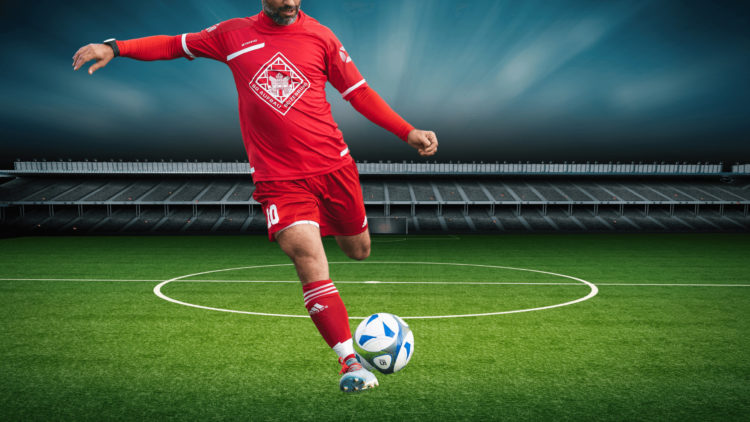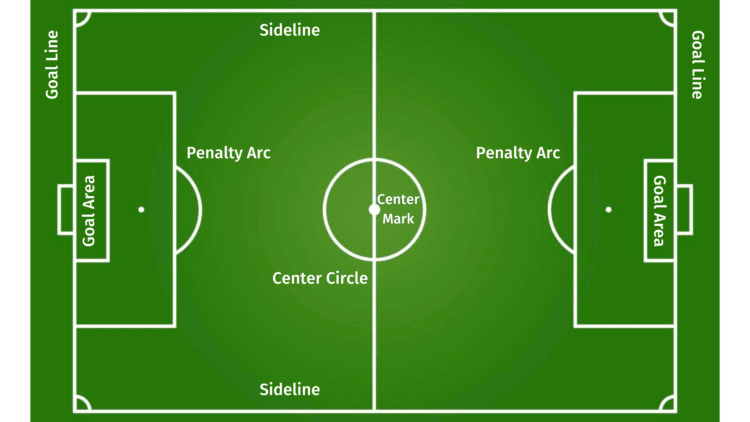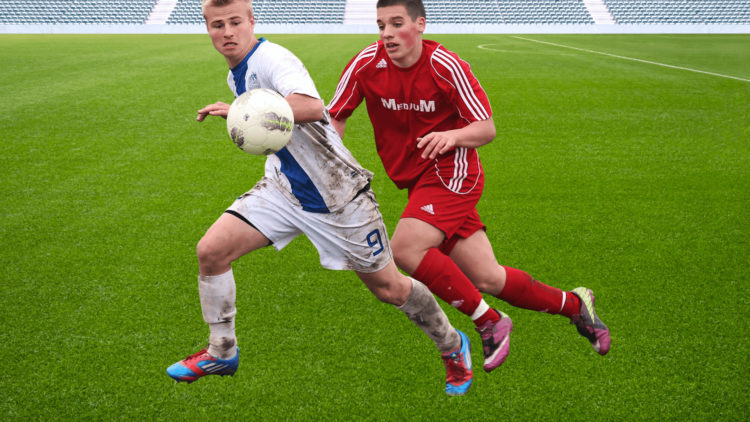
OBJECTIVE OF SOCCER: Score more goals than the other team by kicking the ball into the goal on the other side of the field.
NUMBER OF PLAYERS: 22 players, 11 on each team
MATERIALS OF SOCCER: 1 soccer ball, 2 goals, jersey, shorts, socks, shin guards, cleats, gloves
TYPE OF GAME: Sport
AUDIENCE: All ages
OVERVIEW OF SOCCER

Soccer, or football (not to be confused with American football) for the rest of the world, boasts a rich history. While a variation of soccer may have been played since ancient times, the game is said to have originated in 19th-century England. The first-ever recorded game? That took place in 1863 in London, England, between Barnes Football Club and Richmond Football Club! This game ended in a 0-0 draw.
Over the decades, soccer has successfully crossed and conquered oceans and continents. The FIFA World Cup, inaugurated in 1930, transformed the game into the global spectacle we know today, uniting fans every four years. And ever since, icons like Pelé, Maradona, and Messi have graced the pitch and have become household names around the globe.
The thing about soccer is that it really is more than just a sport. Go to any soccer game, and you’ll see. You can feel the palpable excitement in the air as fans belt out anthems, the collective gasps during penalty shootouts, and the cries and screams of the fans as the ball dances to and fro. Whether you’re sipping mate in Argentina, enjoying sushi in Japan, or sharing a hot dog in the USA, soccer really brings people together like no other force on the planet.
While soccer has strangely not gotten much traction in the United States in the past, it is a quickly-growing sport with stadiums popping up all over the country. If you’re new to this amazing game, welcome! And read on to get to know all the rules of soccer!
SETUP FOR SOCCER
Before we jump into the actual rules of the game, here’s everything you need to know about the setup for soccer, including the field, the positions, and the equipment needed.
SOCCER FIELD

The minimum-sized soccer field should be 50-100 yards in width and 100-130 yards in length. On the field, you’ll find a variety of different lines and circles that signify different parts of the field.
- Sidelines: Also called the touchlines, these two lines mark the side boundaries of the field and run the length of the field.
- Goal lines: The goal lines line the width of the field on either side of the field.
- Halfway line: Also called the center line, this line marks the middle of the field.
- Center circle: On the halfway line, you’ll find a circle with a 10-yard radius.
- Center mark: Exactly on the halfway line in the middle of the center circle, you’ll find the center mark or center point.
- Boxes: Around each goalpost are two boxes: the 6-yard box and the bigger 18-yard box.
- Penalty arc and penalty spot: Each 18-yard box is accompanied by a penalty arc, which is also called the penalty spot.
- Corner arc: Finally, the four corners of the field have a corner arc, which is where any corner kicks are taken.
SOCCER PLAYER POSITIONS
A soccer team consists of 11 players, including a goalie or keeper. Here are the soccer player positions and their roles:
- Goalkeeper: The last line of defense, the goalie stops any attempted shots into the goal.
- Defenders (center back, full back, wingback): The main role is to stop the other team from scoring. These players will generally stay in the back near their goal.
- Midfielders (central, outside, attacking, defensive): They are responsible for playing defense and offense and help create scoring opportunities.
- Forwards (striker, winger, attacker): Forwards create chances to score and score goals for their team.
Besides the goalie, there is not necessarily a set way that players need to be positioned in soccer, but the most common formation across soccer teams is 4-4-2. This includes 2 center forwards in scoring position, 4 midfielders, 2 fullbacks, 2 center backs, and a goalie. We’ll discuss the most common formations in more detail below!
SOCCER EQUIPMENT
Of course, to play soccer, you’re going to want the right soccer equipment as well. Here’s what you’ll need:
- Jersey: A soccer jersey is an important part of a soccer game, as this clearly shows what team the player is playing for. The goalkeeper will usually have a different, brighter color from the rest of the team.
- Shorts: Soccer players generally favor shorts over pants, as they allow for more flexibility and movement.
- Socks: Don’t confuse soccer socks with normal socks! Soccer socks are much longer and much thicker, as these socks cover the player’s shin guards.
- Shin guards: Shin guards are pieces of plastic that protect the player’s ankles and shins.
- Cleats: Also called boots, soccer cleats are an absolute must as they have plastic studs at the bottom of the shoe that help with grip.
- Gloves (only goalies): Goalkeepers need padded gloves to protect their hands and help with grip.
- Soccer ball: And last but not least, you can’t play soccer without a soccer ball!
HOW TO PLAY SOCCER: SOCCER RULES

Now that you know the basics, it’s time to get into the actual soccer rules! While there are some nuances we’ll discuss later regarding the length of a soccer game, at its core, a soccer game is 90 minutes long and played in 2 45-minute halves, with a 15-minute break in between.
KICKOFF
To start a soccer game, the referee tosses a coin to determine which team gets possession of the ball first. The team that wins the coin toss kicks the ball to their team to start the game. But don’t worry! This sport plays fair: The other team gets to kick off in the second half.
MOVING THE BALL
The reason that soccer is also called “football” in other countries is that, well… you use your feet to play! Players can also use their heads and chests to control the ball in any direction, and only the goalie is allowed to use their hands or hold the ball within the 18-yard box.
Players can run with the ball or pass it in order to get the ball across the field to the opposing team’s goalpost in an attempt to score by landing the ball in the goal. Defenders can even take the ball from the opposing team by tackling players who have possession or by intercepting attempted passes.
PENALTIES AND FOULS

At any point during the soccer match, a foul or penalty can be given for any broken rules. A player can commit a foul anywhere on the field, except for the 18-yard box of the opposing team. When a player commits a foul, a free kick is awarded wherever this foul took place. However, if the foul is committed within the 18-yard box of the opposing team, a penalty kick is awarded.
There are a number of different fouls and penalties that can occur in a soccer game. Here are a few examples:
- Handling the ball
- Tripping an opponent
- Holding an opponent
- Attacking an opponent unfairly by kicking or pushing without an attempt for the ball
- Offsides
FREE KICK
As mentioned, a free kick is given to the team when a soccer player from the opposing team commits a foul or breaks a rule. When this happens, the game temporarily stops, and any player from that team can take a free kick from the spot of the foul. Keep in mind that the opposing team must stand at least 10 yards away from the kicker.
There are two types of free kicks: direct free kicks and indirect free kicks.
- Direct free kick: The player can directly shoot at the goal. This is awarded for more serious offenses.
- Indirect free kick: The player must pass the ball to an opponent before the team can attempt to score a goal. This is awarded for more minor offenses.
PENALTY KICK
If the player is fouled in the 18-yard goal box, they are able to take a penalty kick and shoot at the goal from the penalty spot. During a penalty kick, only the goalie is able to defend. Whenever a penalty kick is awarded, the silence permeating throughout the entire stadium is deafening.
If the penalty kick scores, that’s a goal and a point for the team. However, if the player misses, play continues as normal.
RED AND YELLOW CARDS
For major fouls such as cursing, aggressive behavior, leaving the field, or consistent breaking of the rules, the referee may give a soccer player a red or yellow card. If a player is given a red card or 2 yellow cards, they are suspended from the game.
OFFSIDES
A common foul that confuses all new soccer aficionados is offsides. This type of foul doesn’t generally involve any kind of physical contact. Instead, a player is offside if they are further downfield than the furthest defender (minus the goalie, of course) of the opposing team when a teammate passes them the ball. Let’s put these into other words to drill this all-too-important rule in. A player cannot be in between the opposing team’s last defender and the goal line when a teammate passes the ball to them.
OUT OF BOUNDS
When the ball goes out of bounds, there are a few different ways to bring the ball back into play, depending on how the ball went out of bounds.
- Corner kicks: If the ball is kicked out of bounds over the goal line by the defending team, the attacking team can kick the ball from the corner arc.
- Goal kicks: If the ball is kicked out of bounds by the attacking team over the goal line, the defending goalie can kick the ball downfield to bring the ball back into play.
- Throw-ins: If the ball is kicked out of bounds over the sideline, the other team throws the ball back into play.
SCORING
To score in a game of soccer, a team must put the ball in the opposing team’s goal. Note that the rules state that the whole soccer ball must cross the goal line between the goalposts in order to count. To prevent a goal, the opposing goalie can block the ball or catch the ball and throw or kick the ball downfield to a teammate. If the ball manages to go into the goal, the score will only count if the team has committed no penalties while making the goal. A single goal is worth one point.
END OF GAME
The winning team is the team that has the most goals at the end of the game. If the game is tied after any added time, the game either ends in a tie or in a knockout competition, wherein each team completes penalty kicks to determine the winner.
HOW LONG IS A SOCCER GAME?

A soccer game is generally 90 minutes long, which is divided into two halves of 45 minutes each. In between the two halves, there is a 15-minute halftime break in order to allow the players to catch a break. There are no other breaks in the game, so theoretically, a soccer game should last exactly 105 minutes.
But, as with most things, the answer is a bit more nuanced than that.
STOPPAGE TIME
The referees in a soccer game can also allow a few minutes of stoppage time at the end of each half, compensating for any time lost due to substitutions, injuries, goal celebrations, or penalties given. Determined by the referee, generally, this stoppage time is an additional 2 to 5 minutes.
TIED GAME
According to the rules of a professional game, in the event of a tie, the soccer game continues. After the original 90 minutes plus any stoppage time is over, there is a five-minute rest period. Finally, after this short break, there is extra time.
This extra time or overtime is a total of 30 minutes, comprised of two 15-minute halves, with a one-minute break in between. So, that’s a total addition of another 36 minutes on top of the original 105 minutes + stoppage time (if applicable).
Now, this is where things get even more complicated! If the score is still tied after this extra time, the two teams determine the outcome of the match with penalty kicks. Each team takes five shots at the goal, with only the goalkeeper defending.
Finally, if the game is still tied after five shots, the soccer match moves onto “sudden death.” Here, the two teams continue to take shots in alternate order until only one team manages to score.
So, as you can see, the answer to the question is not as simple as you may think!
SOCCER FORMATIONS
Soccer formations are like the strategic blueprints that coaches use to orchestrate their teams. These formations may not seem like much at first, but they dictate player positioning, movement, and interaction. These formations allow coaches to capitalize on their team’s strengths while exploiting the weaknesses of the opposing team. So, as you can see, soccer formations are an incredibly important part of playing this sport!
Here are some of the most popular soccer formations:
- 4-4-2: Features 4 defenders, 4 midfielders, and 2 forwards. It’s a simple but balanced and versatile choice with a strong midfield presence.
- 4-3-3: Features 4 defenders, 3 midfielders, and 3 forwards. Known for its offensive capabilities, this formation enables teams to maintain possession.
- 4-3-2-1: Features 4 defenders, 3 midfielders, 2 forwards, and a lone forward striker. Shaped like a Christmas tree, this formation has a balanced structure.
- 5-3-2: Features 5 defenders, 3 midfielders, and 2 forwards. It is a defensive formation.
THE BEST SOCCER PLAYERS OF ALL TIME
Soccer players are some of the biggest names in the world! Even if you’re not too familiar with the sport, you may have heard of these huge names. In fact, some of these names are so big that they boast some of the biggest sports contracts ever.
- Lionel Messi: Even if you’ve lived under a rock, you’ll be familiar with Messi’s name. Just some of Messi’s accolades include 1 World Cup, 8 Ballons d’Or, 4 Champions Leagues, and 10 La Liga titles.
- Diego Maradona: This Argentine soccer player is considered the best footballer of the 80s and certainly one of the top soccer players of all time. Controversially, his most famous goal of all is the “hand of God” during the quarter-final match at the 1986 FIFA World Cup.
- Pele: Pele has the most career goals of all time and was instrumental in turning Brazil into a soccer or football country. He boasts a number of accolades, including TIME 100 Most Important People of the 20th Century list, Brazil’s all-time leading goalscorer, youngest FIFA World Cup winner, and more!
- Franz Beckenbauer: The ideal center-back, Beckenbauer is the greatest German soccer player of all time. He’s one of only two defenders to win the Ballon d’Or (let alone two!) on top of his countless other domestic and international trophies.
- Johan Cruyff: The co-inventor of ‘Total Football’ and the creator of the ‘Cruyff turn,’ Cruyff basically invented modern football. This was a player that was incredibly entertaining to watch but also had the skills to match.
- Ronaldo: Ronaldo could have been the best soccer player of all time if it weren’t for his knee injuries. He’s a two-time World Cup and Ballon d’Or winner. And his career highlight is likely the exciting 2002 World Cup Golden Shoe for Brazill.
FAQ
What Is a Hat Trick in Soccer?
A hat trick is when a single player scores three goals for their team in just one match – that’s it! These goals don’t have to be in a row.
How Many Players on a Soccer Team?
According to official rules, there are 11 players on a soccer team, consisting of one goalie and ten outfielders. However, an entire matchday squad may comprise 18 players total, which includes the 7 substitutes.
When Was Soccer Invented?
While this sport’s roots date back to ancient China and Mesoamerica, soccer as we know it today was invented in England in the 19th century.
How Long Is Soccer Halftime?
In between the two halves of 45 minutes each, there is a soccer halftime of 15 minutes, which occurs at the end of the first half of the match.
- 25 Top Birthday Party Games for Kids - July 23, 2024
- 40 SUPER FUN GIRLS NIGHT GAMES - July 16, 2024
- 40 Exciting Games to Play When You Are Bored - July 9, 2024